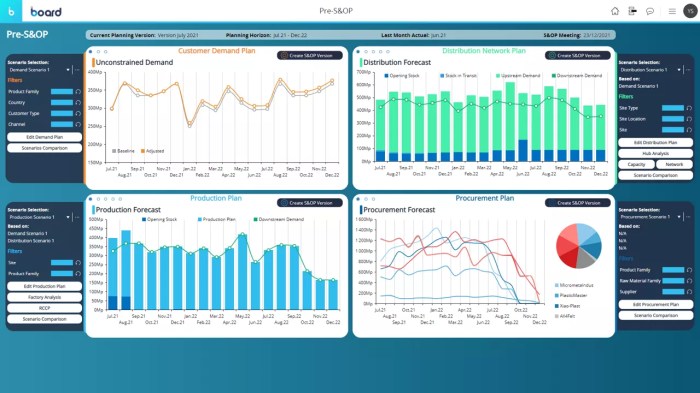Sales & Operations Planning software is revolutionizing how businesses manage their resources and forecast demand. By integrating sales and operations data, these powerful tools provide crucial insights into inventory levels, production capacity, and market trends. This allows companies to make data-driven decisions, optimize their supply chains, and ultimately improve profitability. Effective S&OP software can significantly reduce waste, improve customer satisfaction, and enhance overall operational efficiency.
The core functionality of S&OP software typically includes demand planning, supply planning, inventory management, and sales forecasting. Advanced features might incorporate scenario planning, what-if analysis, and integration with other enterprise resource planning (ERP) systems. The selection of the right S&OP software depends heavily on the size and complexity of the organization, as well as its specific business needs.
In today’s dynamic business environment, effective planning is paramount for success. Sales & Operations Planning (S&OP) software plays a crucial role in aligning sales forecasts with operational capabilities, leading to improved profitability and customer satisfaction. This comprehensive guide delves into the intricacies of S&OP software, exploring its features, benefits, implementation, and future trends. We’ll also address frequently asked questions to provide a clear and concise understanding of this vital business tool.

Source: board.com
What is Sales & Operations Planning (S&OP) Software?
S&OP software is a sophisticated integrated business planning system that facilitates collaboration between sales, marketing, operations, finance, and supply chain departments. It leverages advanced analytics and forecasting techniques to create a unified, data-driven plan that optimizes resource allocation, production schedules, and inventory management. The ultimate goal is to balance supply and demand, minimizing costs and maximizing revenue.
Key Features of S&OP Software, Sales & operations planning software
- Demand Planning: Accurately forecasting future demand based on historical data, market trends, and sales projections. This often involves statistical forecasting models and incorporates external factors like seasonality and economic indicators.
- Supply Planning: Optimizing production capacity, inventory levels, and supply chain logistics to meet forecasted demand. This includes managing raw materials, production processes, and distribution networks.
- Sales Forecasting: Generating precise sales forecasts using various methodologies, including time series analysis, regression analysis, and qualitative methods. This often integrates with CRM data for a more accurate picture.
- Inventory Optimization: Minimizing inventory holding costs while ensuring sufficient stock to meet customer demand. This involves techniques like ABC analysis and safety stock calculations.
- Financial Planning & Analysis (FP&A): Integrating financial data into the planning process, allowing for accurate profit and loss projections and scenario planning.
- Collaboration & Communication: Providing a centralized platform for cross-functional teams to share data, collaborate on plans, and track progress. This fosters better communication and alignment across departments.
- Reporting & Analytics: Generating comprehensive reports and dashboards that provide real-time visibility into key performance indicators (KPIs) and allow for data-driven decision-making. This includes customizable reports and visualizations.
- What-If Analysis & Scenario Planning: Simulating different scenarios (e.g., changes in demand, supply disruptions) to assess potential risks and opportunities and make proactive adjustments to the plan.
Benefits of Implementing S&OP Software
Implementing robust S&OP software offers numerous benefits, contributing significantly to a company’s overall success. These include:
- Improved Forecast Accuracy: Leading to better inventory management and reduced stockouts or overstocking.
- Increased Efficiency & Productivity: Streamlining processes and automating tasks, freeing up time for strategic decision-making.
- Reduced Costs: Minimizing inventory holding costs, waste, and production inefficiencies.
- Enhanced Customer Satisfaction: Meeting customer demand more consistently and reducing lead times.
- Better Collaboration & Communication: Improving cross-functional alignment and breaking down silos.
- Improved Profitability: Optimizing resource allocation and maximizing revenue generation.
- Data-Driven Decision Making: Leveraging real-time data and analytics to make informed decisions.
- Increased Agility & Responsiveness: Adapting quickly to changing market conditions and customer demands.
Choosing the Right S&OP Software
Selecting the appropriate S&OP software requires careful consideration of several factors. These include:
- Scalability: Ensuring the software can adapt to the company’s growth and changing needs.
- Integration Capabilities: Seamless integration with existing ERP, CRM, and other enterprise systems.
- User-Friendliness: An intuitive interface that is easy for users across different departments to navigate and utilize.
- Customization Options: The ability to tailor the software to specific business requirements and workflows.
- Vendor Support & Training: Reliable vendor support and comprehensive training for users.
- Cost & ROI: Evaluating the total cost of ownership (TCO) and the potential return on investment (ROI).
Implementation of S&OP Software
Successfully implementing S&OP software involves a phased approach:
- Needs Assessment: Identifying the specific business needs and objectives that the software should address.
- Software Selection: Evaluating different software options and selecting the best fit for the company’s requirements.
- Data Migration: Transferring existing data from legacy systems to the new S&OP software.
- User Training: Providing comprehensive training to users on how to utilize the software effectively.
- Process Optimization: Streamlining business processes to align with the capabilities of the software.
- Go-Live & Monitoring: Launching the software and continuously monitoring its performance and making necessary adjustments.
Future Trends in S&OP Software
The S&OP software landscape is constantly evolving, with several key trends emerging:
- Artificial Intelligence (AI) & Machine Learning (ML): Integrating AI and ML for more accurate forecasting and automated decision-making.
- Cloud-Based Solutions: Increased adoption of cloud-based S&OP software for improved scalability, accessibility, and cost-effectiveness.
- Advanced Analytics & Data Visualization: Enhanced data visualization capabilities for better insights and decision-making.
- Increased Integration with Other Systems: Seamless integration with a wider range of enterprise systems for a more holistic view of the business.
- Focus on Sustainability: Incorporating sustainability considerations into the planning process.
Frequently Asked Questions (FAQ)
Q: What is the difference between S&OP and demand planning?
A: Demand planning is a component of S&OP. Demand planning focuses solely on forecasting future demand, while S&OP encompasses the entire planning process, integrating demand planning with supply planning, sales forecasting, and financial planning to create a unified plan.
Q: How much does S&OP software cost?
A: The cost of S&OP software varies greatly depending on the vendor, features, and implementation requirements. It can range from a few thousand dollars per year for smaller businesses to hundreds of thousands of dollars for large enterprises.
Q: How long does it take to implement S&OP software?
A: The implementation timeline depends on the complexity of the software and the company’s specific needs. It can range from a few months to over a year.
Q: What are the key metrics for measuring the success of S&OP?
A: Key metrics include forecast accuracy, inventory turnover, on-time delivery, customer satisfaction, and overall profitability.
Conclusion: Sales & Operations Planning Software
Sales & Operations Planning software is an indispensable tool for modern businesses seeking to optimize their operations and enhance profitability. By aligning sales and operations, S&OP software empowers organizations to make data-driven decisions, improve forecast accuracy, and enhance customer satisfaction. Investing in the right S&OP software can significantly contribute to a company’s long-term success.
References
- Gartner (For industry research and insights)
- Oracle (For enterprise resource planning and supply chain solutions)
- SAP (For enterprise resource planning and supply chain solutions)
Call to Action
Ready to optimize your business planning and unlock significant growth potential? Contact us today for a free consultation to explore how S&OP software can benefit your organization.
In conclusion, implementing robust Sales & Operations Planning software offers significant advantages for businesses of all sizes. From improved forecasting accuracy to enhanced supply chain visibility, the benefits extend across various departments, leading to better decision-making, reduced costs, and increased competitiveness. By leveraging the power of data and advanced analytics, companies can gain a strategic edge in today’s dynamic market landscape.
The strategic alignment of sales and operations facilitated by S&OP software is no longer a luxury, but a necessity for sustained success.
FAQ Summary
What are the key benefits of using S&OP software?

Source: nexinfo.com
Improved forecasting accuracy, reduced inventory costs, better resource allocation, enhanced customer service, increased profitability, and stronger supply chain resilience.
How much does S&OP software typically cost?
Pricing varies significantly depending on the vendor, features included, and the size of the implementation. Expect a range from several thousand dollars annually for smaller solutions to hundreds of thousands for enterprise-level deployments.
How long does it take to implement S&OP software?
Implementation timelines vary depending on the complexity of the system and the organization’s internal processes. Expect a timeframe ranging from a few months to over a year for large-scale implementations.
What are the common challenges in implementing S&OP software?
Data integration issues, resistance to change from employees, lack of skilled personnel, and inadequate change management processes are common challenges.
Can S&OP software integrate with my existing ERP system?
Many S&OP software solutions offer integration capabilities with popular ERP systems. However, the specific integration options will vary depending on the software and ERP system used.